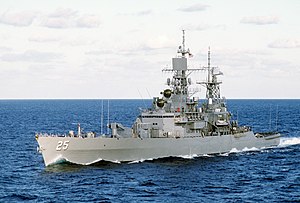利用者:加藤勝憲/1975年アメリカ海軍艦種変更

アメリカ海軍は1975年に多くの水上艦艇を再分類し、巡洋艦、フリゲート艦、護衛駆逐艦の用語と船体分類記号を変更した。
1975年以前の分類
[編集]1950年代から1975年まで、アメリカ海軍には3種類の高速機動部隊護衛艦と1種類の輸送船団護衛艦があった。機動部隊護衛艦は巡洋艦(船体分類記号CAG/CLG/CG)、フリゲートまたは駆逐艦リーダー(DL/DLG)、駆逐艦(DD/DDG)、護衛艦は海洋護衛艦(DE/DEG)で、第二次世界大戦中の艦の名称と番号系列を継承しているので護衛駆逐艦と呼ぶこともある。1970年代前半に追加されたのは、パトロール・フリゲート(PF)と呼ばれる新しい海上護衛艦で、これも第二次世界大戦で使われていた呼称で、オリバー・ハザード・ペリー級の初期呼称だった[1]。1975年にこれらの分類は、巡洋艦(CG)、護衛艦(DD/DDG)、フリゲート(FF/FDG)へと簡略化されている。From the 1950s to 1975, the US Navy had three types of fast task force escorts and one type of convoy escort. The task force escorts were cruisers (hull classification symbols CAG/CLG/CG), frigates or destroyer-leaders (DL/DLG), and destroyers (DD/DDG); the convoy escorts were ocean escorts (DE/DEG), often called destroyer escorts as they retained the designation and number series of the World War II vessels. Added in the early 1970s was a new ocean escort called the patrol frigate (PF), another designation previously used in World War II, which was the initial designation of the Oliver Hazard Perry class. In 1975, these classifications were simplified to cruiser (CG), destroyer (DD/DDG), and frigate (FF/FFG).
1975年以前の分類では、巡洋艦は第二次世界大戦時の砲巡洋艦程度の大きさで、主要な水上戦闘艦として想定された大型艦でした。1隻(USSロングビーチ(CGN-9))を除くすべてが、第二次世界大戦の砲巡洋艦(CL/CLGまたはCA/CAG)を改造したもので、タロスまたはテリア地対空ミサイル(SAM)、場合によってはタルタルミサイルも搭載していました。これらの艦と誘導ミサイルフリゲート艦の主な任務は、ソ連の対艦巡航ミサイルを迎撃することであった。巡洋艦は各空母群に1隻ずつ配属されることになっていた。巡洋艦の改造のほとんどは、誘導ミサイルフリゲート艦が設計・建造されている間に、新しい海軍SAMを迅速に配備するために行われたものである。巡洋艦の改造は、そのコストとフリゲートが巡洋艦とほぼ同数の武器を搭載できることから、比較的少なかった[2]。Under the pre-1975 classification, cruisers were large vessels, the size of World War II gun cruisers, intended as the primary surface combatants. All but one (USS Long Beach (CGN-9)) were converted World War II gun cruisers (CL/CLG or CA/CAG), carrying either Talos or Terrier surface-to-air missiles (SAMs), and in some cases also Tartar missiles. The primary mission of these ships and the guided missile frigates was to intercept Soviet anti-ship cruise missiles. One cruiser was to be assigned to each carrier group. Most of the cruiser conversions were performed to rapidly deploy the new naval SAMs while the guided missile frigates were being designed and built. There were relatively few cruiser conversions, due to their cost and because the frigates could carry almost as many weapons as a cruiser.


1950年から1975年まで、フリゲートは巡洋艦と駆逐艦の中間の大きさで、主要な任務部隊の護衛を目的とした新しいタイプでした。このタイプの最初の船はASW巡洋艦に改名され、次の4隻は非常に大きなAAW(砲)駆逐艦(DL)、残りの船は本質的に特大の誘導ミサイル駆逐艦でDLGと分類されました。中距離ミサイル「テリア」を搭載していたが、攻撃用(戦略用)兵器は搭載していなかった。
駆逐艦は、第二次世界大戦時の設計から、最小の高速機動部隊の護衛艦として開発されました。DDは高速ASW船で、DDGは短距離タルタルミサイルを搭載したAAW船でした。
From 1950 to 1975, frigates were a new type, midway between cruiser and destroyer sizes, intended as major task force escorts. The first ship of the type was a redesignated ASW cruiser; the next four were very large AAW (gun) destroyers (DL), and the remainder were essentially oversize guided missile destroyers classified as DLGs. They carried the mid-range Terrier missile, but no offensive (strategic) weapons.
Destroyers were developed from the World War II designs as the smallest fast task force escorts. DDs were fast ASW ships; DDGs were AAW ships carrying the short-range Tartar missile.
洋上護衛艦は、第二次世界大戦時の駆逐艦護衛艦の発展型である。輸送船団護衛を目的とし、戦時には動員生産、平時には低コストで大量生産できるよう設計されていた。DEはASW艦、DEGはタルタルミサイルを搭載したAAW艦であった。
Ocean escorts were an evolution of the World War II destroyer escort types. They were intended as convoy escorts and were designed for mobilization production in wartime or low-cost mass production in peacetime. DEs were ASW vessels; DEGs were AAW vessels with Tartar missiles.
米国のフリゲート艦の分類は他国の海軍では使われておらず、同様の艦は外国では巡洋艦や駆逐艦であった[3] 。The U.S. frigate classification was not used by any other navy; similar vessels were either cruisers or destroyers in foreign service. The ocean escort type corresponded to foreign frigates (convoy escorts).
「クルーザーギャップ」
[編集]ソ連は「誘導ミサイル巡洋艦」を長距離対艦ミサイルで武装した大型戦艦と定義した。巡洋艦」という言葉には、2隻の大型ヘリ空母(モスクワ級)も含まれていた。米国のフリゲート艦に相当する艦は「大型対潜水艦」に分類されたが、西側諸国では大型の艦を「巡洋艦」と呼んでいた[4]。 このため、1974 年までに、巡洋艦に分類される艦は米国で 6 隻しかなかったが、ソ連では 19 隻が現役で、さらに7隻が建造されていたという結論に至った。(すべての合計は砲艦のみの巡洋艦を除く)。ソ連の2隻を除くすべての艦は、米国のフリゲートにほぼ匹敵し、米国の巡洋艦よりはるかに小さい、比較的小さな艦であった。しかし、1980年頃にハープーンミサイルが導入されるまで、米国の水上戦闘機にはなかった重対艦巡航ミサイル砲台を搭載しているものが多かった。The Soviets defined "guided missile cruisers" as large warships armed with long range anti-ship missiles. The term "cruiser" included also two large helicopter carriers (Moskva class). The ships equivalent to U.S. frigates were classified as "large anti-submarine ships", but the larger of them were designated as "cruisers" by Western navies. This led to a conclusion, that by 1974, there were only six ships in U.S. service classified as cruisers, but the Soviets had 19 cruisers in service with seven more being built. (All totals exclude gun-only cruisers). All but two of the Soviet ships were relatively small vessels, roughly equivalent to U.S. frigates and far smaller than U.S. cruisers. However, most included a heavy anti-ship cruise missile battery that US surface combatants lacked until the introduction of the Harpoon missile circa 1980.
巡洋艦」の定義が米ソで異なっていたため、米ソの海軍力を比較する際に政治的な問題が生じた。米ソの巡洋艦戦力を比較した表では、ソ連の「巡洋艦」と同等かそれ以上の大きさの「フリゲート艦」が 21 隻存在したにもかかわらず、米軍 6 隻対ソ連軍 19 隻となっている。このため、「巡洋艦の差」は存在しないと認識された。The differing U.S. and Soviet definitions of "cruiser" caused political problems when comparisons were made between U.S. and Soviet naval forces. A table comparing U.S. and Soviet cruiser forces showed six U.S. ships vs. 19 Soviet ships, despite the existence of 21 U.S. "frigates" equal or superior in size to the Soviet "cruisers". This led to the perception of a non-existent "cruiser gap".
ギャップの解消
[編集]この「ギャップ」を埋めるために、1975年6月30日に米国のフリゲート(DL/DLG)の分類が廃止された。ガンフリゲート艦(DL)はすでにすべて打ち捨てられるか、DDGに改造されていた。DLGのほとんどは巡洋艦(CG)になったが、小型のファラガットは駆逐艦(DDG)となった。既存または建造中の原子力DLGNはすべてCGNに再指定された。DLGからCGへの変更により、「巡洋艦」はより大型の駆逐艦に近い小型艦として再定義されました。巡洋艦の分類も簡略化され、誘導ミサイル軽巡洋艦(CLG)は単にCGとなった。砲巡洋艦は「CA」の呼称を維持したが、最後に残った砲巡洋艦ニューポートニュースは3日前の1975年6月27日に退役している。To close this "gap," the U.S. frigate (DL/DLG) classification was eliminated on 30 June 1975. All the gun frigates (DL) had already been stricken or converted to DDGs. Most of the DLGs became cruisers (CG), but the smaller Farraguts became destroyers (DDG). All of the nuclear-powered DLGNs, existing or in construction, were redesignated as CGNs. The change from DLG to CG redefined "cruiser" as smaller ships, more like large destroyers. Cruiser classifications were also simplified, with the guided missile light cruisers (CLG) simply becoming CGs. Gun cruisers retained the "CA" designation although the last remaining gun cruiser, Newport News, was decommissioned three days earlier on 27 June 1975.
海洋護衛艦(DE/DEG)とパトロールフリゲート艦(PF)はフリゲート(FF)または誘導ミサイルフリゲート艦(FFG)になった[1]。
これらの変更により、アメリカ海軍の分類は外国の分類と一致するようになり、"巡洋艦ギャップ "と認識されていたものが解消された。The ocean escorts (DE/DEG) and patrol frigates (PF) became frigates (FF) or guided missile frigates (FFG).
These changes brought U.S. Navy classifications into line with foreign classifications, and eliminated the perceived "cruiser gap."
| 1975年6月29日まで | 1975年6月30日以降 |
| Cruiser (CA/CLG/CGN) | Guided Missile Cruiser (CG/CGN) |
| Frigate (DL/DLG/DLGN) | Guided Missile Cruiser (CG/CGN), Destroyer (DD), or Guided Missile Destroyer (DDG) |
| Destroyer (DD/DDG) | Destroyer (DD) or Guided Missile Destroyer (DDG) |
| Ocean Escort (DE/DEG) | Frigate (FF) or Guided Missile Frigate (FFG) |
| Patrol Frigate (PF) | Guided Missile Frigate (FFG) |
1980年1月1日、【次のテンプレートが機能しない→ 】Template:Sclassタイコンデロガ級誘導ミサイル駆逐艦(DDG)が誘導ミサイル巡洋艦(CG)となり、最後の変化が訪れた。A final change came on 1 January 1980, when the Ticonderoga class guided missile destroyers (DDG) became guided missile cruisers (CG).
References
[編集]
Sources
[編集]- sci.military.naval, “F.8”, Part F Surface Combatants FAQ, Hazegray.
- Bauer, K. Jack; Roberts, Stephen S. (1991). Register of Ships of the U.S. Navy, 1775-1990: Major Combatants. Westport, Connecticut: Greenwood Press. ISBN 0-313-26202-0
- Friedman, Norman (1984). U.S. Cruisers: An Illustrated Design History. Annapolis, Maryland: Naval Institute Press. ISBN 0-87021-718-6
[[Category:1975年のアメリカ合衆国]] [[Category:未査読の翻訳があるページ]]
